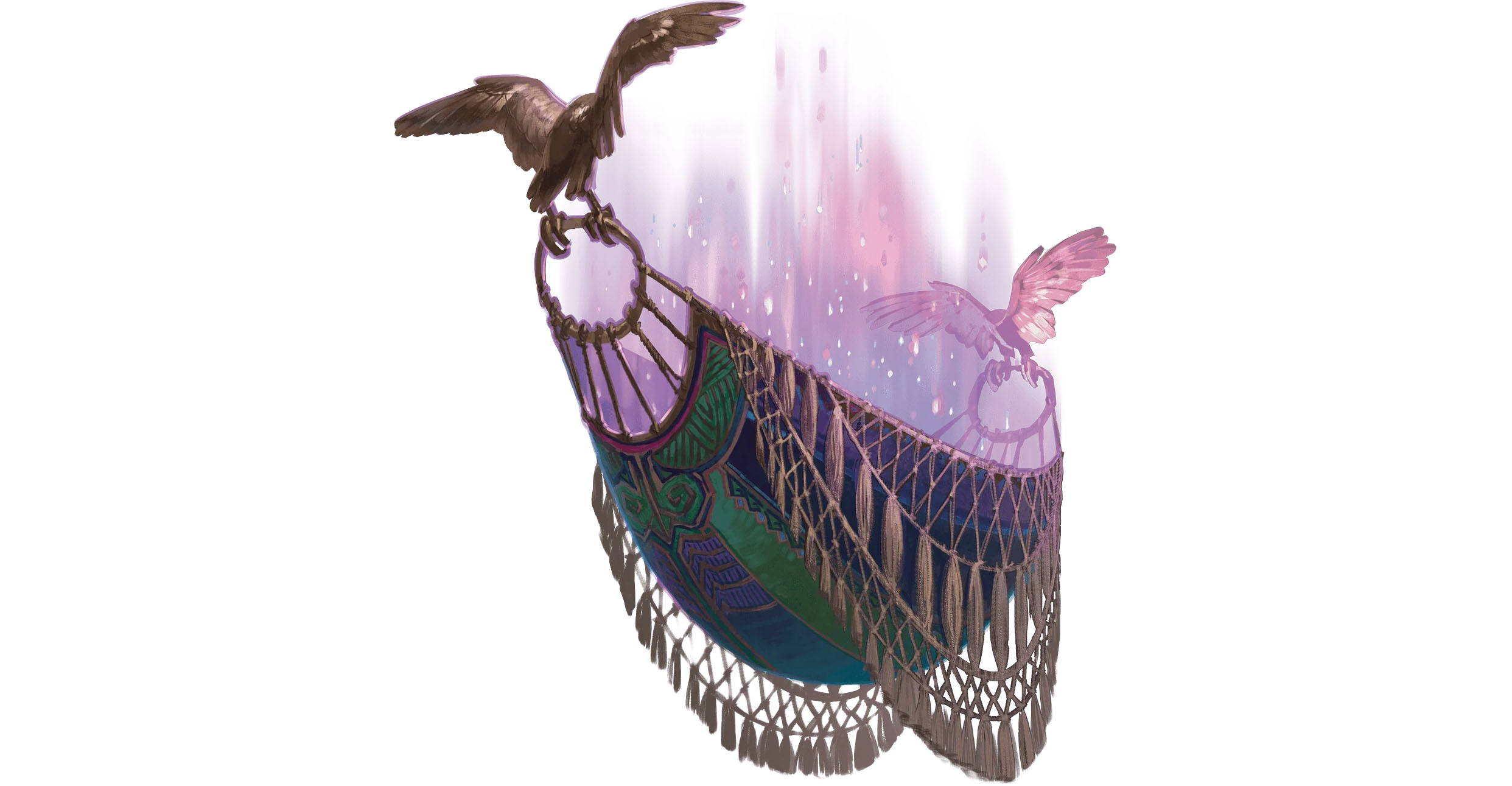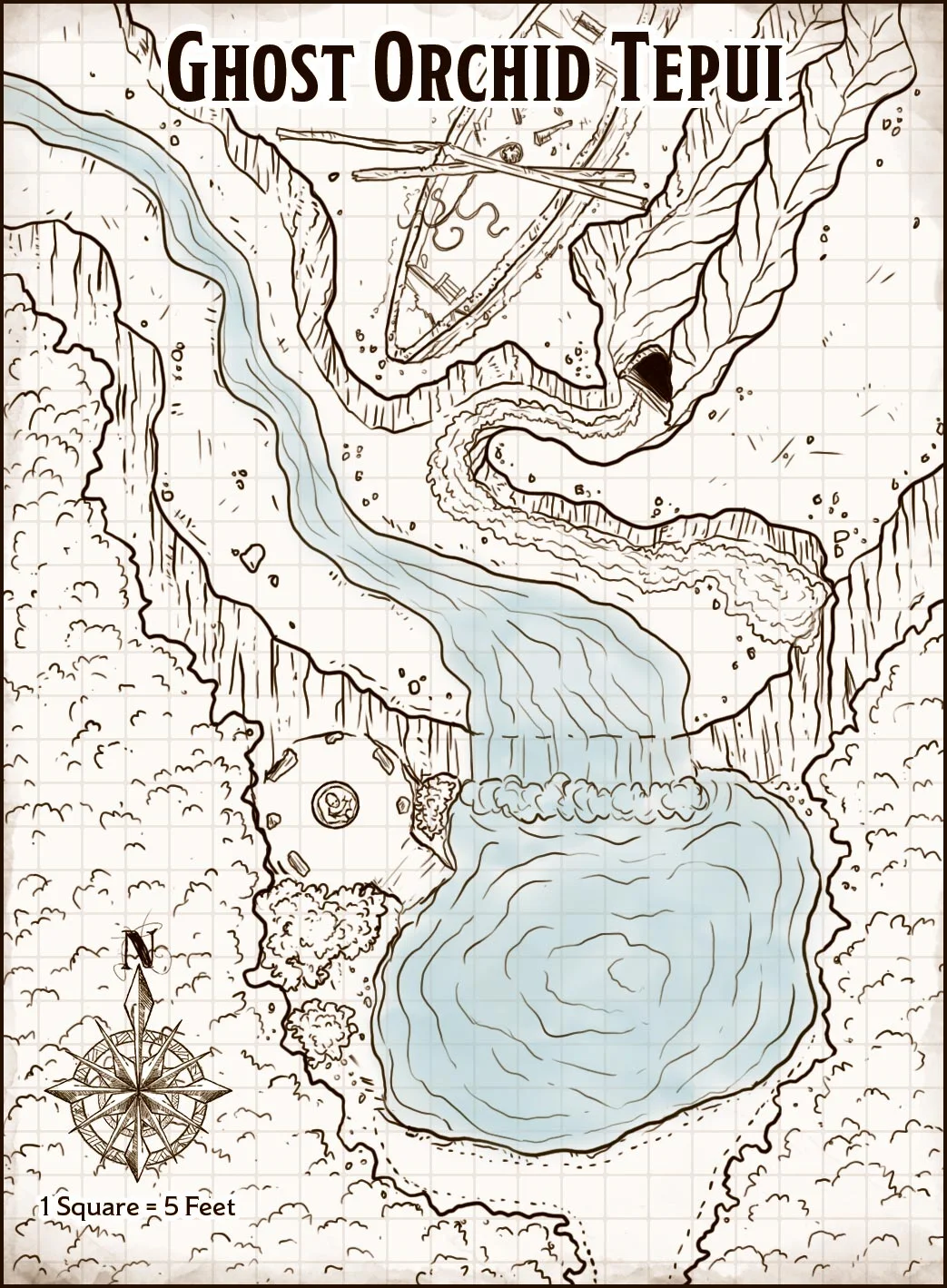ORCHIDS OF THE INVISIBLE MOUNTAIN (Terry H. Romero): I actually quite like this scenario, and I’d like you to keep that in mind while I discuss its two major problems. (Then we’ll cycle back around to the good stuff.)
First, there’s a trend I’ve seen in Wizards of the Coast adventures — particularly in their anthologies — of designing a scenario hook that offers an intriguing enigma for curious players to investigate, but then immediately having an NPC show up who barges in, orders the PCs to investigate it, and gives them a specific checklist of tasks to complete. Frequently, this NPC will also just immediately explain the enigma, robbing the adventure of any sense of discovery, but nevertheless leaving the busy work.
“Look, I’m going to be perfectly honest with you,” the DM says. “I think you’re all idiots and incapable of taking any action unless someone is literally holding you hand. Hang on a sec, let me wipe the drool off your chins.”
In the case of “Orchids of the Invisible Mountain,” it feels particularly weird because the strange enigma is literally an NPC ordering the PCs to do a thing. And then another NPC shows up so that they, too, can order the PCs to do the exact same thing.
It’s like you’re stuck in some kind of middle-management hell.
The second problem with “Orchids of the Invisible Mountain” is what I refer to as scale mismatch.
“Orchids” wants to be an epic fantasy quest. It wants the vast scope and epoch-shattering consequences of The Lord of the Rings as the PCs journey forth on a grand expedition across many worlds, interacting with legendary characters and god-like beings.
But, on the other hand, it’s fifteen pages long.
It’s basically impossible for adventures like this to achieve their lofty goals, and so they end up feeling hollow and forced. You can’t squeeze Frodo’s journey to Mordor into a one-shot and expect it to have the same weight.
(There’s also a sad little bit where the text basically says, “If the PCs have plane shift, of course, they can just skip most of this adventure.” This feels like somebody in the development process realized there was a calibration problem between what the adventure expected and what 14th-level characters are actually capable of, but it was too late to actually fix it. You can see a similar calibration problem near the beginning of the adventure, where the text confidently states that the PCs will have no way of stopping a barn fire.)
You can see a dramatic example of this scale problem in action with this map of a “mountain” which is… what? About a hundred feet across?
Having said all that, the reason I’m rather fond of “Orchids” is that it’s actually remarkably effective at evoking the epic scale it’s grasping for. Far more so than any similar module I’ve seen. It achieves this primarily by just daring to dream vividly, conjuring forth dream-hazed visions that are startlingly memorable by virtue of being both unique and drawn in specific detail.
“Orchids” will take you:
- Through a burning sugar plantation.
- Across the thri-keen-haunted Grassroads.
- Into a giant termite mound which is also a thinning between this world and the Feywild.
- Up the jungle-tangled slopes of the Ghost Orchid Tepui.
- Into the Crystal Caves where the Sleeping Stone is guarded by an aboleth-cursed dragon.
- The husk of the Drought Elder, an alien god of the Far Realm whose consciousness echoes through its own dead skein.
Along the way they’ll meet:
- The Sugar Man, an ebullient leader of the people of Atagua.
- A thousand-year-old spirit kept alive by the whim of the Feywild.
- An iridescent thri-keen.
- The Dawn Mother, an ageless giant striding out of legend.
There’s nothing generic here. It’s all fantastical and wonderful and strikingly imaginative, hampered only by the necessity of its just-in-time-exposition: The PCs need to go to the Dawn Mother, and so now we’ll tell them about the Dawn Mother for the first time.
“Orchids of the Invisible Mountain” would be much more powerful if the seeds of its lore were planted much earlier in your campaign. (It’s just so much cooler if the players have known about the legends of the Dawn Mother for a long time, and now they get to actually meet her!) Planting those seeds would mean doing a lot of groundwork.
But “Orchids” just might be worth it.
Grade: C+
CONCLUSION
As with my review of Candlekeep Mysteries, what I’m looking for in an anthology is not necessarily a home run with every entry. I’m much more interested in how much good stuff the anthology offers me. It’s fairly easy to just ignore the stuff that doesn’t work.
Bearing that in mind, let’s take a peek at the hit rate for Journeys Through the Radiant Citadel:
Salted Legacy C+
Written in Blood A
The Fiend of Hollow Mine C+
Wages of Vice D
Sins of Our Elders C-
Gold for Fools and Princes F
Trail of Destruction D-
In the Mists of Manivarsha C
Between Tangled Roots B
Shadow of the Sun F
The Nightsea's Succor B+
Buried Dynasty F
Orchids of the Invisible Mountain C+
Anything with an A or B grade is an adventure I would definitely run. Stuff with a C grade I’m more skeptical of, but are likely salvageable if you particularly like the concept or content.
So of the thirteen adventures we have:
- 3 that I would definitely run;
- 5 that could be salvaged with a little TLC; and
- 5 that I think are a complete miss.
It’s clear from these numbers that this is a weaker anthology than Candlekeep Mysteries (which scored 8/4/5 on this metric). But this is a pretty good showing for an anthology like this, and when you combine it with the gazetteer for the Radiant Citadel itself — which I simply adore — I can easily recommend Journeys Through the Radiant Citadel as a solid value.
Style: 4
Substance: 3
Project Lead: Ajit A. George, F. Wesley Schneider
Writing: Justice Ramin Arman, Domnique Dickey, Ajit A. George, Basheer Ghouse, Alastor Guzman, D. Fox Harrell, T.K. Johnson, Felice Tzehuei Kuan, Surena Marie, Mimi Mondal, Mario Ortegón, Miyuki Jane Pinkcard, Pam Punzalan, Erin Roberts, Terry H. Romero, Stephanie Yoon
Rules Development: Jeremy Crawford, Makenzie De Armas, Ben Petrisor, Taymoor Rehman
Publisher: Wizards of the Coast
Cost: $49.95
Page Count: 224
FURTHER READING
Journeys Through the Radiant Citadel: A List of Names
Review: Candlekeep Mysteries














For a company that appears to want a piece of all D&D action everywhere and to be going hammer and tongs about how wonderful Official D&D is, I’d want a much better rate than 3/13 being ready to run. Especially for fifty bucks.
Especially given their trumpeting how this is a diversity showcase. If you do a diversity showcase, I feel like there’s a responsibility to not have it be a trash fire, because of the implications that creates.
Things seem to be firmly back into “the fans should buy anything we make and should thank us for the privilege” territory.
Radiant Citadel seems light on quality.
I agree with Simulated Knave: how can Wizards act so contemptuous to third party creators and then sell a product with this low of a hit rate? How can they claim to “need” to destroy 20+ years of third party creativity in order to prevent “hateful” products, and then release a Blue Lives Matter adventure? It’s really a shame to see “Official D&D” thrashing around so badly, right before the golden anniversary year too.
We live in an era where you can get fairly competent adventures for peanuts thanks to the DMsGuild, etc. It’s so hard to justify buying a book with such a low success rate just to maybe run 1-2 of the adventures. WotC really needs to focus more on quality over quantity. I would be far more likely to buy a book like this if it had about 5 less adventures but each one was of superior quality. Plus much of that page count could be used to better flush out the locations, especially the Citadel itself. Ghosts of Saltmarsh’s 1st chapter is a great example of what should have been done.
It seems to me like Radiant Citadel might have been better off as a setting book to give the authors more room to expand their individual worlds, and then they could have released their adventures through DMsGuild or something. This book would need to be significantly marked down before I bought it, which seems a shame, because a lot of these worlds and the ideas introduced seem really cool.